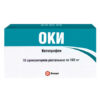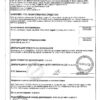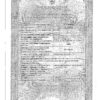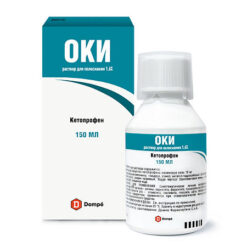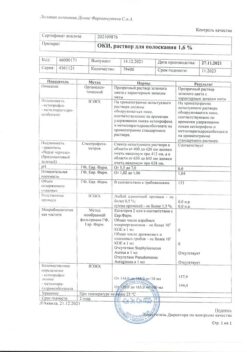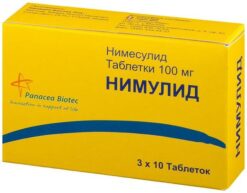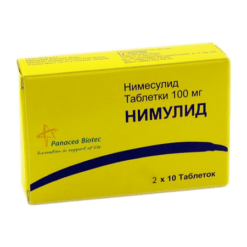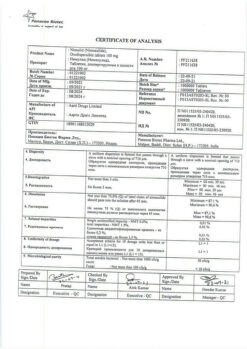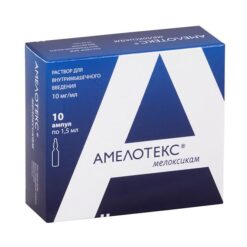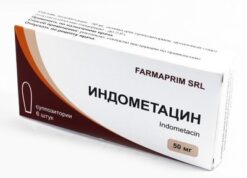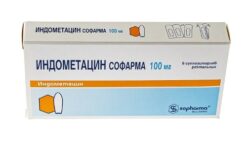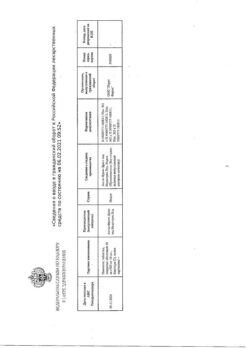No products in the cart.
OKI, rectal 160 mg 10 pcs
€8.31 €6.93
Out of stock
(E-mail when Stock is available)
Description
Pharmacotherapeutic group. Non-steroidal anti-inflammatory drug (NSAID).
ATX code: M01AE03
Pharmacological properties
It has anti-inflammatory, analgesic and antipyretic effects. By inhibiting cyclooxygenase types I and II, inhibits the synthesis of prostaglandins. It has anti-bradykinin activity, stabilizes lysosomal membranes and inhibits release of the enzymes from them, which contribute to destruction of tissues during chronic inflammation. Reduces the release of cytokines, inhibits neutrophil activity.
Reduces morning stiffness and joint swelling, increases range of motion. Ketoprofen lysine salt, unlike ketoprofen, is a rapidly soluble molecule with neutral pH and almost does not irritate the gastrointestinal tract.
Pharmacokinetics.
Absorption. Ketoprofen lysine salt is quickly absorbed: time of reaching maximum concentration (Tshah) after rectal administration is 45-60 minutes. Plasma concentrations are linearly dependent on the dose taken. Distribution. Up to 99% of absorbed ketoprofen is bound to plasma proteins, mainly to albumin. The volume of distribution is 0.1-0.2 l/kg. It easily passes through histohematic barriers and is distributed in tissues and organs. Ketoprofen penetrates well into the synovial fluid and connective tissues. Although concentrations of ketoprofen in synovial fluid are slightly lower than in plasma, they are more stable (persists up to 30 hours).
Metabolism. Ketoprofen is mainly metabolized in liver, where it undergoes glucuronidation with formation of esters with glucuronic acid. Excretion. Metabolites are eliminated mainly in the urine (up to 76% after 24 hours). The drug does not cumulate.
Indications
Indications
Symptomatic treatment of inflammatory processes accompanied by fever and pain, including inflammatory and rheumatic joint diseases:
Active ingredient
Active ingredient
Composition
Composition
ketoprofen lysine salt 160 mg
excipients: semisynthetic glycerides – 1640 mg
How to take, the dosage
How to take, the dosage
Interaction
Interaction
Inducers of microsomal oxidation in the liver (phenytoin, ethanol, barbiturates, flumecinol, rifampicin, phenylbutazone, tricyclic antidepressants) increase the production of hydroxylated active metabolites.
Decreases the effectiveness of uricosuric drugs, increases the effect of anticoagulants, antiaggregants, fibrinolytics, ethanol, the side effects of mineralcorticosteroids, glucocorticosteroids, estrogens. Combined use with other NSAIDs, glucocorticosteroids, ethanol, corticotropin may lead to ulcer formation and development of gastrointestinal bleeding, increased risk of renal dysfunction.
Simultaneous use with oral anticoagulants, heparin, thrombolytics, antiaggregants, cefaperazone, cefamandole and cefotetan increases the risk of bleeding.
Increases hypoglycemic action of insulin and oral hypoglycemic drugs (requires recalculation of the dose).
Combination with sodium valproate causes platelet aggregation disorders. Increases plasma concentrations of verapamil and nifedipine, lithium drugs, methotrexate. Antacids and colestyramine reduce absorption.
Pregnancy and lactation. Like other NSAIDs, OCI should not be used in the third trimester of pregnancy. The use of the drug in the first and second trimester should be closely monitored by the attending physician. Breast-feeding should be discontinued when using the drug.
Special Instructions
Special Instructions
The peripheral blood count and the functional state of the liver and kidneys should be monitored during treatment. If it is necessary to determine 17-ketosteroids, the drug should be discontinued 48 hours before the study.
Ketoprofen administration may mask the signs of infectious disease. In case of renal and hepatic dysfunction the dose should be reduced and closely monitored. The use of ketoprofen in patients with bronchial asthma may lead to an attack of bronchial asthma.
Women who are planning to become pregnant should refrain from taking the drug, as the likelihood of oocyte implantation may be reduced.
Impact on the ability to drive and operate machinery.
When using the drug, one should refrain from potentially hazardous activities requiring concentration and quick psychomotor reactions.
Contraindications
Contraindications
Hypersensitivity (including to other NSAIDs), “aspirin” asthma, gastric and 12 duodenal ulcer (acute condition), ulcerative colitis (acute condition), Crohn’s disease, diverticulitis, peptic ulcer, hemophilia and other blood clotting disorders, CVD, childhood age (under 18 years), pregnancy (III trimester), lactation period.
With caution – anemia, bronchial asthma, alcoholism, tobacco smoking, alcoholic cirrhosis, hyperbilirubinemia, liver failure, diabetes, dehydration, sepsis, CHF, edemas, arterial hypertension, blood diseases (including leukopenia).In case of worsening of the patient’s condition the drug should be discontinued.
In case of worsening of the patient’s condition the drug should be discontinued.
Side effects
Side effects
Gastrointestinal tract: abdominal pain, diarrhea, duodenitis, gastrointestinal erosive ulcers, gastritis, hematomesis, esophagitis, stomatitis, melena.
Liver:increased bilirubin, increased “liver” enzymes, hepatitis, liver failure, increased liver size.
Nervous system:dizziness, hyperkinesia, tremor, vertigo, mood swings, anxiety, hallucinations, irritability, general malaise.
Senses:conjunctivitis, visual disturbances.
Skin: urticaria, angioedema, erythematous exanthema, pruritus, maculopapular exanthema, increased sweating, erythema multiforme (including Stevens-Johnson syndrome).
Urogenital system:painful urination, cystitis, edema, hematuria, menstrual disorders.
Hematopoietic organs:leukocytopenia, leukocytosis, lymphangitis, decreased prothrombin time, purpura, thrombocytopenia, thrombocytopenic purpura, increased spleen size, vasculitis.
Respiratory system: bronchospasm, dyspnea, sensation of laryngeal spasm, laryngospasm, laryngeal edema, rhinitis.
Cardiovascular system:hypertension, hypotension, tachycardia, chest pain, syncope, peripheral edema, pallor.
Allergic reactions:anaphylactoid reactions, oral mucosal edema, pharyngeal edema, periorbital edema.
Testinal reactions:burning, itching, heaviness in the anorectal area, exacerbation of hemorrhoids.
Overdose
Overdose
Similarities
Similarities
Additional information
| Shelf life | 5 years. Do not use the drug after the date on the package. |
|---|---|
| Conditions of storage | At a temperature not exceeding 25°C. Keep out of reach of children. |
| Manufacturer | Dompe Pharmaceutici S.p.A., Italy |
| Medication form | rectal suppositories |
| Brand | Dompe Pharmaceutici S.p.A. |
Other forms…
Related products
Buy OKI, rectal 160 mg 10 pcs with delivery to USA, UK, Europe and over 120 other countries.





